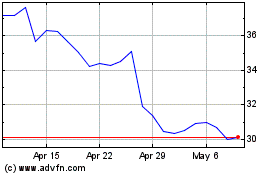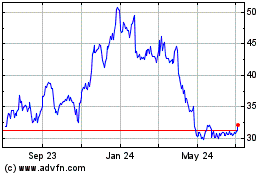Intel Fires Back At Rivals With New Line of Server Chips
July 11 2017 - 11:44AM
Dow Jones News
By Ted Greenwald
Intel Corp. on Tuesday brought to market a new generation of
chips used in the servers that run data centers, firing back at
competitors who lately have moved to challenge its hegemony in its
most profitable market.
The rollout of the Xeon Scalable Family, an updated line of 58
processors priced from roughly $200 to $10,000 each, highlighted
Intel's ambition to maintain its hold over all segments of the data
center market.
Intel makes most of its revenue on processors for personal
computers, but the powerful server chips bring higher prices and
profit margins. The server-chip division reported an
operating-profit margin of 44% in fiscal 2016 compared with 32% in
the segment that sells PC chips.
The server business has become more strategic lately as sales of
personal computers have plateaued in recent years.
Intel holds nearly 100% of the $16.5 billion global market for
server chips that run the software instructions called x86 that
form the foundation of nearly all commercial software, according to
Mercury Research.
But Intel's server business shows signs of contracting. Although
the chip giant has said it expects double-digit revenue growth in
its data-center division in coming years, half of that growth will
come not from chips but from ancillary products like storage and
networking, according to Bernstein Research analyst Stacy Rasgon.
In addition, Intel has said that profit margins in its data center
segment would narrow as that business absorbs more of the costs of
developing new manufacturing methods.
Meanwhile, the server sector has attracted a raft of rivals.
Advanced Micro Devices Inc. in June started shipping its Epyc line
of server chips aimed squarely at the lower-priced half of Intel's
offerings. Those products, AMD's first entry into the data-center
market since 2013, are giving server makers a welcome alternative
for Intel's products. However, any impact on Intel won't become
clear for some time.
Qualcomm Inc. and Cavium Inc. in March demonstrated chips
running Microsoft Corp.'s Windows Server operating system based on
technology from ARM Holdings, a division of SoftBank Group Corp.
Microsoft has said it expects to use such chips in its Azure cloud
service. International Business Machines Corp. has announced new
server chips expected later this year.
And the boom in artificial intelligence has spurred sales of
graphics processors made by Nvidia Corp., which has overshadowed
Intel in the training phase of machine learning.
Intel responded to the newly competitive environment with a New
York launch event Tuesday where it touted partnerships with
prominent software and hardware vendors, endorsements from
Amazon.com Inc. and Alphabet Inc.'s Google -- an early Xeon
Scalable Family customer -- and boasts of its central role in three
systems that are candidates for an annual list of top 500
supercomputers.
Spanning a range of uses and cost-per-performance
characteristics, the new product line is intended to encourage
customers to move into higher-price products, the company said.
Moreover, it is tightly coupled to Intel memory, data storage,
networking, and accelerator products intended to win the company a
larger portion of data-center budgets.
Intel claimed that the top-of-the-line Xeon Scalable Family unit
delivers nearly two-thirds higher performance, on average, than the
company's previous most-powerful server processor. It presented
dozens of what Intel called "world record" scores on performance
tests on various applications.
Industry watchers tend to withhold judgment about performance
until independent test results become available and generally agree
that performance is only one of many factors crucial to market
success.
"Anyone can put together a [processor] that will look good on
paper from a feature-comparison standpoint," said Lisa Spelman,
Intel's VP of data center marketing. But it is harder to build "a
well balanced system that can use the highest capacity of every
feature it has," she said.
Write to Ted Greenwald at Ted.Greenwald@wsj.com
(END) Dow Jones Newswires
July 11, 2017 12:29 ET (16:29 GMT)
Copyright (c) 2017 Dow Jones & Company, Inc.
Intel (NASDAQ:INTC)
Historical Stock Chart
From Mar 2024 to Apr 2024

Intel (NASDAQ:INTC)
Historical Stock Chart
From Apr 2023 to Apr 2024
